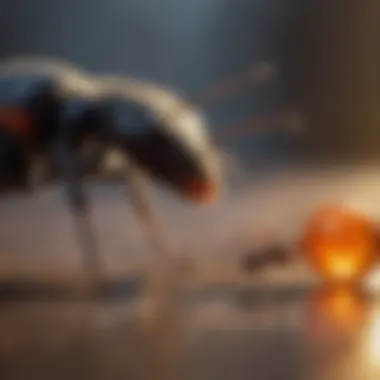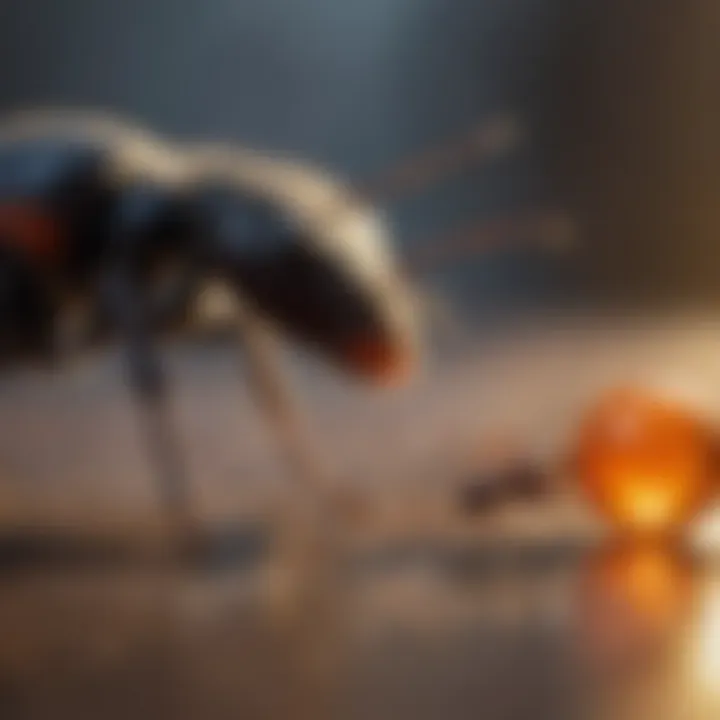Understanding Terro Indoor Ant Bait: A Comprehensive Guide


Intro
The prevalence of ants in households is a common issue that many homeowners face. Understanding how to effectively manage these pests can save time, money, and frustration. This article will delve into Terro Indoor Ant Bait—a widely used solution that aims to control ant infestations indoors. By examining its formulation, effectiveness, and proper application methods, readers can become better equipped to tackle their ant problems. Furthermore, safety precautions and alternative solutions will also be discussed, providing a rounded perspective on indoor ant management.
Pest Identification
Identifying the type of ant is crucial for effective control. Here are some common ant species typically found indoors:
- Carpenter Ants: They tend to be large and black or a mixture of black and red. These ants are notorious for creating nests in wooden structures, leading to potential damage.
- Sugar Ants: Smaller and often light brown, sugar ants are drawn to sugary substances. They are commonly found in kitchens and pantries.
- Pavement Ants: These are dark brown to black ants, small in size. They often enter homes in search of food and shelter.
Signs and Symptoms of Infestations
Recognizing an ant infestation can begin with simple observations:
- Visible Trails: Ants often follow a pheromone trail to food. Finding a line of ants moving in a consistent direction can indicate where they are entering and the source of food.
- Nesting Sites: Presence of small piles of debris, like wood shavings or soil around window sills and door frames, can suggest a nearby nest.
- Food Contamination: Ants can invade food storage areas, leading to contaminated food items.
Prevention Strategies
Preventative measures can significantly decrease the likelihood of infestations.
Home Maintenance Tips for Pest Prevention
To protect your home from ants, consider these maintenance tips:
- Seal Cracks and Crevices: Apply caulk to cracks in walls, windows, and around doors to limit entry points.
- Maintain Cleanliness: Regularly clean countertops, floors, and other surfaces to remove food particles that may attract ants.
- Store Food Properly: Use airtight containers for pantry items to avoid drawing ants.
Natural Deterrents and Barriers
Utilizing natural alternatives can also aid in prevention:
- Vinegar Solution: A mixture of equal parts water and vinegar can be sprayed in areas where ants are seen. This disrupts their pheromone trails.
- Essential Oils: Oils like peppermint or tea tree create scent barriers that ants typically avoid.
Treatment Options
When prevention fails, treatment becomes necessary.
Overview of Chemical vs. Natural Treatments
Choosing between chemical and natural options depends on personal preferences and safety considerations. Terro Indoor Ant Bait is a well-regarded chemical solution, specifically designed for indoor ant control. However, natural remedies also exist and can be effective depending on the extent of the infestation.
Step-by-Step Guides for DIY Treatments
If you choose to proceed with DIY solutions, here is a simple guide:
- Identify the Ant Trails: Observe where the ants are coming from.
- Create a Bait: Mix sugar with baking soda. Sugar attracts ants, while baking soda is toxic to them.
- Lay the Bait: Place it near the ant trail but out of reach of pets and children.
- Monitor the Situation: Check over the next few days to see if the ant population decreases.
Using bait, like Terro Indoor Ant Bait, is advantageous as it targets the colony instead of just the visible ants.
In summary, understanding the characteristics of indoor ants, recognizing signs of infestations, and knowing how to implement effective prevention and treatment methods are key components for effective ant control. This guide aims to provide a thorough view of what homeowners need to manage ant problems effectively.
Prologue to Terro Indoor Ant Bait
Indoor ant infestations can be frustrating. They invade kitchens and dining areas, searching for food and water. Terro Indoor Ant Bait offers homeowners a solution to these pesky problems. This section discusses why understanding this ant bait is essential. It covers aspects that make Terro a popular choice among pest control methods. By knowing its effectiveness, application, and safety, homeowners can make informed decisions to protect their living spaces.
Purpose of the Article
The purpose of this article is to provide a thorough understanding of Terro Indoor Ant Bait. It is meant for homeowners, particularly those who might be experiencing ant problems. The article aims to inform readers about the formulation, use, and advantages of Terro products. Additionally, we will address potential limitations and misconceptions. Through this comprehensive guide, readers will learn effective techniques to manage ant infestations, ultimately improving their home environment.


Overview of Terro Products
Terro is a brand known for its range of ant control products. Terro Indoor Ant Bait stands out due to its effectiveness and ease of use. It comes in various forms, including liquid bait and bait stations. The liquid bait is designed to attract ants, allowing them to consume the poison and return to their colony. This is an essential feature because it helps in targeting the root of the infestation.
Moreover, Terro products are user-friendly. Typical instructions make it easy for homeowners to use them correctly. This enhances the overall experience and ensures maximum effectiveness.
In summary, Terro Indoor Ant Bait is a valuable option for managing indoor ant problems. Understanding its applications and benefits is crucial for effective pest control.
Understanding Ant Behavior
Understanding ant behavior is crucial for implementing effective control measures, especially when it comes to using products like Terro Indoor Ant Bait.
This section will explore key aspects of ant behavior, helping homeowners and pest control professionals to discern the underlying mechanisms that drive ant infestations. Knowing how ants operate informs better strategies for bait placement, improves treatment outcomes, and ultimately aids in long-term prevention measures.
Types of Ants Common in Homes
There are several ant species that frequently invade indoor spaces. Each type exhibits unique behaviors and preferences, which can affect how you deal with them. Some of the most common ant species include:
- Carpenter Ants: Known for nesting in wood, they may cause significant structural damage to homes if not controlled.
- Odorous House Ants: Named for their distinctive smell when crushed, these ants are persistent foragers often found in kitchens and food storage areas.
- Pavement Ants: These ants typically build nests under pavement and can be seen forging inside homes in search of food.
- Thief Ants: Known for invading other ants' nests, they are small and can be difficult to detect at first glance.
Understanding these species is essential. Each one reacts differently to bait systems like Terro. Recognizing which ant is causing the issue allows for targeted baiting strategies, ensuring that the right bait is used for the respective ant species.
Ant Foraging Patterns
Ant foraging patterns are critical to consider when deploying bait like Terro. Ants typically forage in distinct ways depending on their species and environment. Key considerations include:
- Foraging Trails: Ants often establish trails leading to and from food sources. These trails become habitual, making them reliable paths for bait placement.
- Scouting Behavior: Individual ants may scout for resources before communicating findings to the colony. Understanding this behavior can help you identify peak foraging times when bait will be most effective.
- Food Preferences: Ants can be attracted to various foods, and this preference can shift depending on the season or type of infestation. Combining bait with food substances they prefer increases effectiveness.
Understanding these patterns enables you to optimize the placement and effectiveness of Terro Indoor Ant Bait. It helps in predicting where ants are likely to forage and allows for a more strategic approach in both bait placement and timing.
"Recognizing the type of ants and their foraging patterns is not just beneficial; it is essential for successful ant management strategies."
By addressing these details of ant behavior, homeowners can approach ant infestations with informed awareness, leading to more successful outcomes when using Terro Indoor Ant Bait.
Composition and Mechanism of Action
Understanding the composition and mechanism of action of Terro Indoor Ant Bait is essential for recognizing its effectiveness and proper use. The choice of ingredients and how they affect ant behavior play a crucial role in successful pest management. Being aware of these aspects can help homeowners make informed decisions when dealing with ant infestations.
Active Ingredients in Terro Bait
Terro Indoor Ant Bait primarily utilizes sodium tetraborate as its active ingredient. This compound is renowned for its efficacy in eliminating ant colonies. Sodium tetraborate acts slowly, allowing ants to carry the bait back to their nests. Other supporting ingredients include sugars that attract the ants, making the bait appealing.
Understanding these components is vital. Sodium tetraborate is safe for humans and pets when used correctly. Its low toxicity contrasts with some more aggressive pest control options. However, this does not mean it is without risks. Misuse or over-application can lead to undesirable effects in your living space. A thorough read of product instructions can clarify any doubts.
How Terro Bait Affects Ant Colonies
The mechanism of action for Terro Bait revolves around its ability to disrupt the biological processes within an ant colony. When ants consume Terro Bait, they return to their nest and share it with others through a natural behavior known as trophallaxis, which is essentially food sharing. This leads to the gradual elimination of the entire colony due to the delayed effects of sodium tetraborate.
"This delayed action is critical. Ants do not recognize they are consuming a poison, allowing more members to be affected before they understand the danger."
Employing this method has several advantages. It might take several days to see a significant reduction in ant activity, but this approach targets the source rather than just the visible ants. In contrast to some instant-kill options, Terro fosters a more strategic methods of dealing with ant problems. This can be particularly useful for homeowners looking to maintain a long-term solution to ant infestations.
Application Methods
Understanding the right application methods for Terro Indoor Ant Bait is essential for effective pest control. The way the bait is utilized directly impacts its efficiency against ant infestations. Correct application ensures that the bait reaches the ants and is also consumed, which helps in eliminating entire colonies.
There are several factors to consider when applying Terro Indoor Ant Bait. The first is identification of the ant trails. Ants follow pheromone trails laid by others, making it important to place the bait along these pathways. This increases the likelihood of the bait being discovered and consumed by foraging ants.
In addition, the placement of the bait must also consider areas with high ant activity. These areas may include kitchens, dining rooms, and around garbage bins. Properly identifying these locations enhances the bait's efficacy.
Where to Place the Bait


When deciding where to place Terro Indoor Ant Bait, it is critical to observe the ant behavior in your home. Begin by tracking the ants' movements. Look for where they enter and exit, as well as any nests or colonies nearby. The bait should be placed as close as possible to these locations.
- Common Locations for Bait Placement:
- Along kitchen countertops and cabinets
- Near pet food areas
- By windows and doors where ants might enter
- Close to trash cans or recycling bins
Using bait stations also allows for discreet placement in hard-to-reach areas. Ensure the bait is not disturbed by pets or children for optimal results. Also, avoid placing the bait in areas that are wet or have high moisture levels, as this can reduce its effectiveness.
Frequency and Duration of Use
The effectiveness of Terro Indoor Ant Bait relies not just on placement, but also on its use frequency and duration. It is advisable to monitor the bait stations regularly. If the bait is consumed, replace it promptly to ensure a constant supply for foraging ants.
- Recommended Guidelines for Use:
- Check bait stations every few days for activity
- Replace the bait if it is empty or contaminated
- Continue using bait until there is no ant activity for a couple of weeks
Generally, the bait can be used continuously for several weeks. However, the duration depends on the level of infestation. For persistent issues, additional methods may be required.
Utilizing Terro Indoor Ant Bait consistently and observing ant activity ensures successful control of the problem. Understanding these aspects of application methods is crucial for homeowners aiming for a pest-free environment.
Effectiveness of Terro Indoor Ant Bait
The effectiveness of Terro Indoor Ant Bait is a central theme in understanding how to manage indoor ant problems. Homeowners face various challenges when dealing with ant infestations, and knowing the strengths of this product aids in effective control measures. Terro Indoor Ant Bait offers a targeted approach that combines baiting methods with active ingredients designed to attract and eliminate ant colonies. This section explores the key factors that contribute to its success and how it compares to other ant control methods.
Factors Influencing Efficacy
Several factors can influence the effectiveness of Terro Indoor Ant Bait. These include environmental conditions, ant species, and placement of the bait.
- Environmental Factors: Temperature and humidity play a significant role in the bait's attraction. Ants are more active in warm conditions, which can lead to better foraging behavior.
- Ant Species: Different ant species have varying preferences for food sources. The formulation in Terro may be more attractive to some species, such as sugar-loving ants. Understanding the target ants in your home can significantly enhance effectiveness.
- Placement: The success of the bait heavily relies on strategic placement. Locating the bait near ant trails and areas of known activity ensures that the ants discover it quickly.
These factors combined can either enhance or hinder the results. Monitoring the situation post-application helps to assess if adjustments are necessary.
Comparison with Other Ant Control Methods
When comparing Terro Indoor Ant Bait to other ant control solutions, several distinctions emerge. Terro can be effective where other methods might fall short. For instance:
- Liquid Insecticides: These may provide immediate results but can fail to eliminate the entire colony since they mainly kill ants upon contact. Terro, on the other hand, acts systemically, targeting the colony through bait.
- Granular Baits: While these might cover larger areas, they can be less appealing to specific ant species. In contrast, Terro has a formulation that attracts certain types of ants more effectively.
- Natural Alternatives: Some homeowners may opt for vinegar or essential oils. While these methods can deter ants temporarily, they often lack the lethal component that Terro delivers to ant colonies.
In summary, while multiple methods exist for ant control, Terro Indoor Ant Bait has unique advantages that cater to persistent infestations. For optimal outcomes, understanding these comparisons helps homeowners make informed choices.
"The key to successful ant management is selecting the right product based on specific circumstances and ant behavior."
By appreciating the nuances of effectiveness in products like Terro, homeowners can better equip themselves to handle ant problems efficiently. Whether it’s the active ingredients or the application technique, every detail becomes vital in the quest for a pest-free home.
Safety and Environmental Considerations
When using any pest control product, especially those designed for indoor use, the focus on safety and environmental considerations is paramount. Terro Indoor Ant Bait is popular for its effectiveness in controlling ant infestations, but it is essential to understand the safety measures associated with its use. For homeowners, particularly those with pets or small children, knowing the risks and best practices can ensure a safe environment while addressing ant problems.
Toxicity to Pets and Humans
Terro Indoor Ant Bait is formulated to target specific ant species while posing minimal risk to humans and animals. However, caution is necessary. The active ingredient in Terro products is a low concentration of borax. This compound works as a slow-acting poison, allowing worker ants to return to their colony and distribute the bait, which ultimately leads to the elimination of the entire colony. Although borax is less toxic than many household chemicals, ingestion can be harmful:
- Pets: Dogs and cats are curious creatures that may investigate or play with bait stations. It is essential to place the bait out of their reach. If a pet ingests Terro bait, it may experience symptoms like vomiting or diarrhea. In severe cases, emergency veterinary treatment might be needed.
- Humans: While borax has a low toxicity level, the bait should not be ingested by children. To prevent accidental exposure, keep bait stations in areas that are inaccessible to young children.
Educating family members about the locations of the bait stations can further help in maintaining a safe environment.
Disposal of Used Bait Stations


The disposal of used bait stations is an often overlooked aspect of pest control. Proper disposal practices help minimize environmental impact and reduce risks to humans and pets. Here are some guidelines to follow:
- Follow Manufacturer Instructions: Always check the packaging for specific disposal instructions. Terro's guidelines generally recommend sealing used bait stations in a plastic bag before placing them in the trash.
- Avoid Flushing: Do not flush bait stations or their contents down the toilet or sink as this can harm wastewater systems.
- Recycle Wisely: Some parts of bait stations may be recyclable. However, it is crucial to ensure that any residual bait is removed to prevent accidental exposure to wildlife or pets.
- Keep out of Reach: Ensure that disposed bait stations are secure and away from animals and children during disposal, as residual bait can pose risks even after use.
By adhering to these disposal methods and being cognizant of the potential risks, individuals can manage their pest control measures responsibly and effectively while ensuring the safety of their households.
Common Myths About Ant Bait
Understanding the misconceptions surrounding ant bait is crucial for effective pest control. Many homeowners and housewives rely on various ant control methods, so it’s essential to separate fact from myths. Recognizing these misconceptions can lead to better decisions and more successful outcomes in managing infestations. This section explores common myths about Terro Indoor Ant Bait and ant control in general, providing clear, factual insights.
Misconceptions About Ant Control
One prevalent belief is that using ant bait will drive ants away from the area. In reality, ant bait is designed to attract ants, not repel them. When ants consume the bait, they take it back to their colony, where it has the potential to eliminate not only the foragers but also other members, including the queen.
Another common misconception is that all ant baits work the same way. Some people think that any bait type will solve their ant problems, but different formulations cater to different ant species. Terro, for example, uses a sweet liquid formula that is effective for sugar-loving ants. It’s essential to identify the species of ant to choose the right bait.
Some individuals also believe that once the ants are gone, there is no need for further action. However, ant control is often about prevention. Even after using bait successfully, maintaining sanitation and exclusion tactics is necessary to avoid future infestations.
The Truth About Natural Alternatives
The idea that natural remedies can completely replace commercial ant baits is a pervasive myth. Many homeowners believe that essential oils or vinegar will solve their ant problems without needing baits like Terro. While these natural alternatives can deter ants temporarily, they often lack the effectiveness needed to eliminate colonie.
Terro Indoor Ant Bait, on the other hand, contains specific ingredients to target ants effectively. This means that while natural solutions have their place in pest prevention, they may not provide a long-term solution for a significant infestation.
Additionally, some might think that using multiple methods leads to quicker results. However, combining too many treatments can confuse the ant colony, leading to increased stubbornness. In most cases, a singular approach, when executed correctly, is more effective.
In summary, addressing these myths helps in understanding how Terro Indoor Ant Bait works and why it is often more reliable than many natural alternatives. Proper use of bait, in conjunction with good sanitation practices, is the key to keeping your home ant-free.
Preventive Measures Against Ant Infestations
Taking preventive measures against ant infestations is crucial for homeowners. Ants are persistent pests that can enter homes through small cracks, and once inside, they can reproduce quickly. If a suitable environment exists, ants may quickly establish colonies, causing more significant problems. Thus, preventing these pests is not just about eliminating them once they appear; it involves strategies that keep them from entering in the first place. This section will cover effective approaches to deter ants, focusing on sanitation practices and exclusion techniques.
Sanitation Practices
Sanitation plays a vital role in preventing ant infestations. Ants are drawn to food and other organic materials available in any household. By keeping your environment clean, you can significantly reduce the chances of attracting these pests. Here are some key sanitation practices to adopt:
- Clean Up Food Debris: Regularly wipe down counters and tables to remove crumbs and spills.
- Proper Food Storage: Store food in airtight containers to prevent access for ants.
- Waste Management: Dispose of garbage frequently and ensure that the trash can has a tight-fitting lid.
- Pet Food: Don't leave pet food out for extended periods, as it may attract ants.
- Regular Cleaning Routines: Develop a weekly cleaning schedule that includes floors, cabinets, and other areas ants may visit.
By implementing these practices, you create a less inviting environment for ants, thereby reducing the likelihood of an infestation.
Exclusion Techniques
Exclusion techniques focus on keeping ants from entering your home altogether. This approach involves blocking their access routes and eliminating any potential nesting points nearby. Consider the following measures:
- Seal Cracks and Gaps: Inspect your home for any cracks in walls or gaps around doors and windows. Use caulk to seal these openings timely.
- Repair Screens: Ensure that windows and doors are fitted with tight screens to prevent ants from entering.
- Outdoor Maintenance: Keep a distance between plants and shrubs and the house. Trim branches that may provide easy access to your roof.
- Proper Drainage: Ensure that water does not collect near the house's foundation, as this can attract ants.
Adopting these exclusion techniques can substantially lower the chance of ants setting up shop in your home.
Effective prevention requires a combination of sanitation and exclusion methods. The best way to manage ants is to stop them from entering in the first place.
Ending
The conclusion of this article serves as a crucial part for readers who want to grasp the overall insights discussed regarding Terro Indoor Ant Bait. It summarizes the essence of the bait’s effectiveness, application methods, and safety considerations. Understanding the conclusion can lead to informed decisions about ant control methods, particularly for homeowners facing infestations.
Summary of Key Points
In this section, we revisit some key points presented earlier in the article.
- Terro Indoor Ant Bait is formulated to be both effective and safe. Its active ingredients specifically target common household ants. The bait works by attracting ants, which then carry it back to their colonies, effectively reducing the population.
- Proper application methods involve strategically placing the bait in areas where ants are active. This increases the chances of the bait reaching the nest. Frequent monitoring and timely replacement of the bait ensure continued efficacy.
- Safety for pets and humans is addressed through careful usage. Understanding how to properly dispose of used bait stations can minimize any environmental impact.
Final Thoughts on Ant Control
"Effective ant control is more than just baiting; it requires reducing attractants and taking proactive steps to deter future infestations."
Integrating various methods will not only address current ant issues but prevent future ones, creating a more comfortable living environment. Careful consideration of baiting practices and their place among other pest management strategies is essential for long-term success in managing indoor ants.



